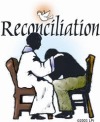 10 Ways The Church Might Change: Point 2
10 Ways The Church Might Change: Point 2
[In previous blogs I have outlined 10 possible changes the Church may face in the future. This is point 2 in the series: The Church has worked hard on its vertical relationship with God through worship and praise (John 3:16). Now it will be forced to work on the horizontal relationship of brother/sister to brother/sister in redefining how the family of God functions (IJohn 3:16). Where those two planes intersect is at the center of the Cross, thus reinforcing that the Cross is the center of the Christian experience. There is where the Church will find the Presence of God!]
In the last blog, I explained the two diagonal planes of the Cross: vertical being man’s relationship with his God and horizontal being man’s relationship to man. Both were broken by sin, but restored by the shed blood of Jesus on the Cross. He hung against these intersecting points, playing the price for sin and reconciling or restoring man’s relationship with his God and with man. In this blog, I would like to examine the horizontal plane, and what it would take to restore man’s relationship with man in Christianity and in the Church as a whole.
 I John 3:16 states: “We know love by this, that He laid down His life for us; and we ought to lay down our lives for the brethren.” I know that United States Marines have been taught this principle, and it is the backbone of unity in their military unit to the point they won’t even allow a dead body to remain on the battlefield to be marred by the enemy. The enforcement of that principle is central to that secular military force, but in Christianity and in the Church I find that principle to be a paradox, for Christians are known for shooting, criticizing, and shunning their wounded, not laying down their lives for them. I must admit, as a Christian of 50 years, I have more fingers on my right hand than I have Christians who I know who would be willing to lay down their lives for me, not criticize me, but accept me with “unconditional love” in spite my short comings even though I am a Christian.
I John 3:16 states: “We know love by this, that He laid down His life for us; and we ought to lay down our lives for the brethren.” I know that United States Marines have been taught this principle, and it is the backbone of unity in their military unit to the point they won’t even allow a dead body to remain on the battlefield to be marred by the enemy. The enforcement of that principle is central to that secular military force, but in Christianity and in the Church I find that principle to be a paradox, for Christians are known for shooting, criticizing, and shunning their wounded, not laying down their lives for them. I must admit, as a Christian of 50 years, I have more fingers on my right hand than I have Christians who I know who would be willing to lay down their lives for me, not criticize me, but accept me with “unconditional love” in spite my short comings even though I am a Christian.
How can this healing, this breach of fellowship and acceptance among believers, brethren, in Jesus Christ ever become a reality, for it must become a reality as a prerequisite for the Second Coming of Jesus Christ, when his Bride, the Church, will be without spot and wrinkle. This is the essence, I believe, of the next true global revival that will be established on this earth. Here are some things that must be done:
 I remember when the American Church in the last century faced its racial prejudices when I was at a national Men’s Prayer Rally called “Standing In The Gap” sponsored by Promise Keepers that filled up the Mall from the Capitol Building to the Washington Monument in Washington, DC. Whites were asking their native American Indian brethren and Black brethren whom they mistreated through slavery or slaughter for forgiveness. It was a beginning, but now the Church needs to begin:
I remember when the American Church in the last century faced its racial prejudices when I was at a national Men’s Prayer Rally called “Standing In The Gap” sponsored by Promise Keepers that filled up the Mall from the Capitol Building to the Washington Monument in Washington, DC. Whites were asking their native American Indian brethren and Black brethren whom they mistreated through slavery or slaughter for forgiveness. It was a beginning, but now the Church needs to begin:
 - to embrace one another as brethren, in the same family, the family of God, the Church, not by denominational sectarian labels that divide and emphasize our differences rather than what we have in common: Jesus! Inbred fighting and bickering is a cancer, a sickness, a disease the Church must rid itself of. The Church knows the true meaning of “RECONCILIATION” in theory, in intellect, but finds it had to practice it in practicality among its brethren. “Let’s not just be hearers of the word, BUT DOERS.” Let’s practice reconciliation among ourselves.
- to embrace one another as brethren, in the same family, the family of God, the Church, not by denominational sectarian labels that divide and emphasize our differences rather than what we have in common: Jesus! Inbred fighting and bickering is a cancer, a sickness, a disease the Church must rid itself of. The Church knows the true meaning of “RECONCILIATION” in theory, in intellect, but finds it had to practice it in practicality among its brethren. “Let’s not just be hearers of the word, BUT DOERS.” Let’s practice reconciliation among ourselves.
 - to embrace one another beyond our hypocritical phony tolerance image of each other, but begin to extend GRACE, unmerited FAVOR, unconditional LOVE to other brethren of different doctrinal persuasion rather than fighting for one’s elite cause of self-righteousness as if our exclusive group is the only one that has the correct light and understanding of Christian truth and Biblical interpretation. Jesus supersedes denominational doctrine!
- to embrace one another beyond our hypocritical phony tolerance image of each other, but begin to extend GRACE, unmerited FAVOR, unconditional LOVE to other brethren of different doctrinal persuasion rather than fighting for one’s elite cause of self-righteousness as if our exclusive group is the only one that has the correct light and understanding of Christian truth and Biblical interpretation. Jesus supersedes denominational doctrine!
 - to embrace the five fold in this generation, recognizing the need for the apostolic. The apostle, in the New Testament Biblical sense “saw over” what the Holy Spirit was doing and recorded it in the Bible as the Acts of the Apostles book. They did not “oversee”, lord over, or control as worldly ruler do, but only “saw over” what the Holy Spirit was doing and were faithfully obedient to what they heard and saw. That is what the Epistles is all about. With the restoration of the apostolic will come apostolic teaching bringing unity of doctrine which also kept the Church together in the first century.
- to embrace the five fold in this generation, recognizing the need for the apostolic. The apostle, in the New Testament Biblical sense “saw over” what the Holy Spirit was doing and recorded it in the Bible as the Acts of the Apostles book. They did not “oversee”, lord over, or control as worldly ruler do, but only “saw over” what the Holy Spirit was doing and were faithfully obedient to what they heard and saw. That is what the Epistles is all about. With the restoration of the apostolic will come apostolic teaching bringing unity of doctrine which also kept the Church together in the first century.
- to embrace the importance of “relationships” within the body of Christ, not positions. The strength of a local body of Christ is built on their relationships. The pulling together of resources, the equipping, training, and mentoring one another, and the releasing of one another to fulfill their destiny and calling in Jesus Christ is the fabric of that strength.
 - to recognize the trappings of American culture. Americans are too busy to reach out to others or get involved. We are too busy taking their kids to soccer, baseball, and football practice, ballet, dance, or gymnastics, school programs, church programs, and civic programs. Our children’s relationships are built around school friends and Facebook friends in an attempt to be popular. We have to teach our children to love the unlovely, build relationships that will last, not superficial popular ones, and how to build relationships properly.
- to recognize the trappings of American culture. Americans are too busy to reach out to others or get involved. We are too busy taking their kids to soccer, baseball, and football practice, ballet, dance, or gymnastics, school programs, church programs, and civic programs. Our children’s relationships are built around school friends and Facebook friends in an attempt to be popular. We have to teach our children to love the unlovely, build relationships that will last, not superficial popular ones, and how to build relationships properly.
These are just a few ideas of how to start the I John 3:16 process of laying down our lives for the brethren. In order to experience revival to this and following generations we must embrace these concepts if we are to be an effective twenty-first century Church.